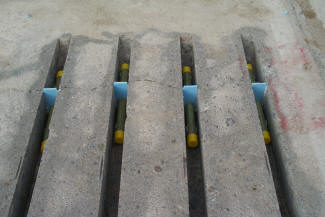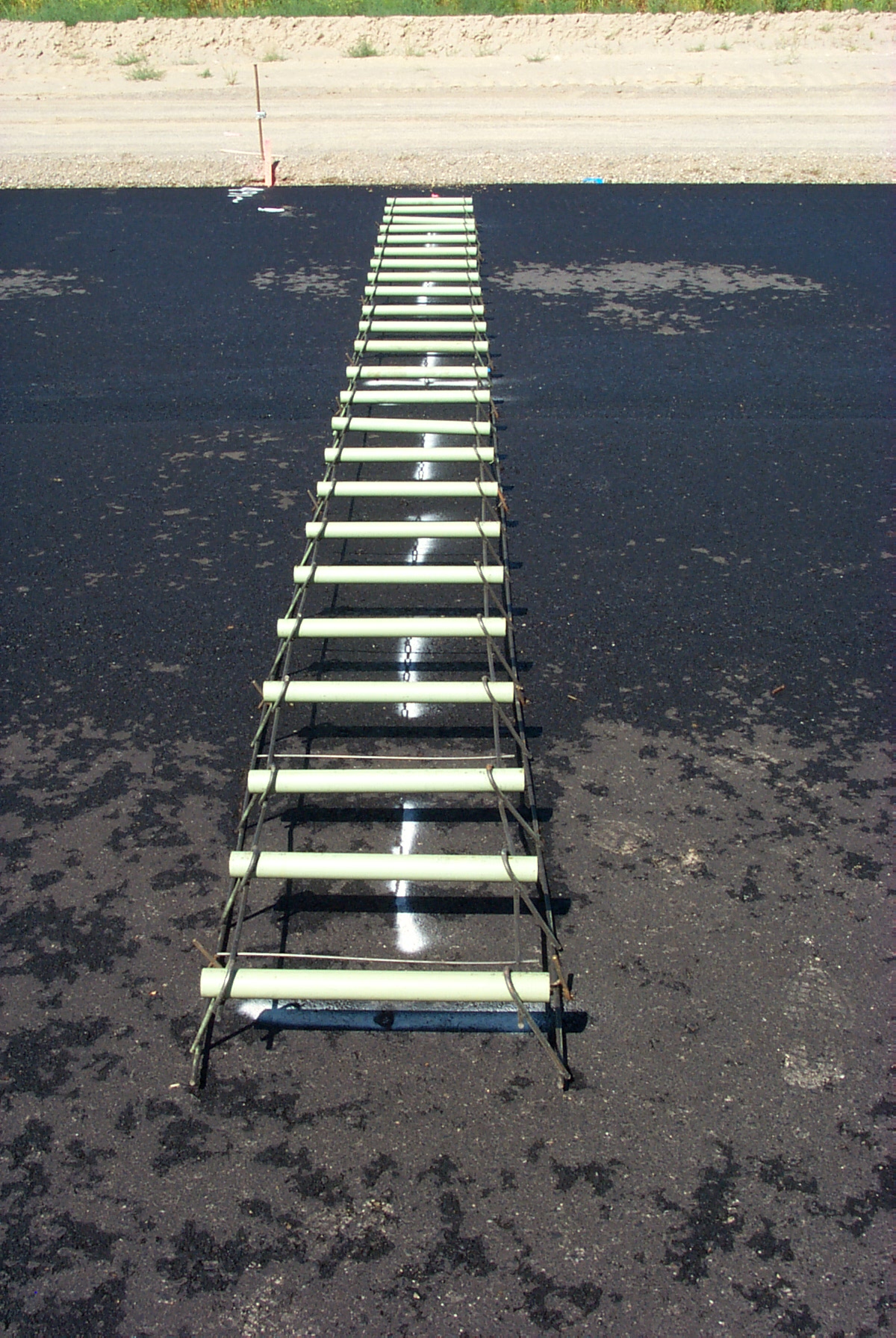How can two things be connected and separate at the same time? That may sound contradictory, but it’s an important part of how concrete pavements work. Concrete can expand or contract with changes in temperature, so pavements are divided into slabs to prevent cracking and allow them to move independently. At the same time, the slabs must stay connected so loads can be shifted from one slab to the next, and to prevent faulting at the joints between slabs. In this edition of the RoadReady newsletter, we’ll look at how this is accomplished by using dowel bars.
Dowel bars are short steel rods placed at the transverse joints of a concrete pavement to provide a connection between slabs. When a joint is created, some level of load transfer can be achieved by aggregate interlock between the two concrete slabs at the joint. However, higher traffic loads (especially trucks) increase the stresses on the slab edges beyond this level, so dowel bars are recommended to provide load transfer. In addition, aggregate interlock will not be effective if horizontal slab movement widens the crack at the joint. The dowel bars act to spread the load across both slabs when traffic is moving off the edge of one slab to the next.
Uses of Dowel Bars
Dowel bars can be used in both new construction and rehabilitation projects such as slab replacement. In addition, they can be retrofitted into existing pavements that were built without dowel bars originally. Adding dowel bars can extend the service life of a pavement by improving load transfer and helping to prevent faulting at pavement joints.
Placement in New Construction
Placement of dowel bars is handled in several different ways, depending on the type of project. For new construction, dowel bars are often set up ahead of time in baskets (simple wire frames) that hold the bars at the appropriate height within the slab. Baskets should be placed at each location where there will be a transverse joint, and the joint will be cut with a saw afterward. Another alternative with slipform paving is to use a dowel bar inserter, which is an attachment to the paver that inserts the bars at the correct location in the fresh concrete.

Placement for Rehabilitation and Retrofit
Rehabilitation and retrofitting require that the dowel bars be inserted into existing concrete, so some additional effort is involved. For a slab replacement, a series of holes is drilled in the adjacent slab into which the dowel bars are inserted. Automated drilling equipment is available that can drill multiple dowel holes simultaneously. The bars are then already in place when the concrete for the replacement slab is poured. When multiple slabs in a row need replacement, dowel bars at the joints between those slabs can simply be placed using baskets, just as you would for new construction.
In a retrofit, dowel bars are inserted at joints of existing concrete slabs that did not have them before. This involves cutting a slot in the concrete where each dowel bar is to go, and the dowel bars are placed in special chairs to ensure they are at the correct position and alignment within the slot. Debris should be cleaned out of the slot prior to placement, after which gap around the dowel bar will be filled with a quick-setting cement grout material. Diamond grinding is then typically performed to ensure a level concrete surface.

Dowel Bar Types
The type of bar to use is an important consideration, since dowel bars need to last as long as the rest of the roadway. In this regard, the corrosion resistance of the dowel bars is a critical feature, depending on their exposure to moisture and climate conditions. Dowel bars are available made from a number of different materials, ranging from plain, uncoated steel to solid stainless steel. The dowel bar types that exhibit the most resistance to corrosion also tend to have correspondingly higher costs, as shown in the table below.
Table showing dowel bar types in order from most corrosion-resistant to least.
| Solid stainless steel |
| Stainless steel clad |
| Stainless steel sleeve, epoxy-coated insert |
| High chromium steel |
| Zinc clad |
| Epoxy-coated steel |
| Plain, uncoated steel |
High chromium steel refers to a formulation of steel that contains a higher chromium content, but less than that required to qualify as stainless steel. Dowel bars of this type are among the most popular, since they can provide good corrosion resistance while being significantly cheaper than stainless steel. In addition to epoxy coating for corrosion resistance, dowel bars need to be coated with a bond breaker material. This prevents them from bonding to the concrete and allows adjacent slabs to move horizontally while the dowel bar remains in place to provide load transfer.
Dowel Bar Spacing and Alignment
In order to serve their load transfer function properly, dowel bars need to be correctly positioned. Vertically, the dowel bar should normally be located at mid-depth of the slab. With respect to horizontal spacing, dowel bars are typically placed 12 inches apart, starting with the first bar 12 inches from the edge of the slab. (If placed any closer to the slab edge, the dowel bars themselves may create stresses that could damage the slab.) For retrofitting, dowel bars are commonly placed only in the wheelpaths to reduce the number of slots that must be cut in the pavement.
Properly installed dowel bars are a vital part of the joint between two concrete pavement slabs. They allow freedom of movement in an otherwise rigid pavement structure, while also maintaining the essential connection of the pavement. By transferring traffic loads between slabs, they work to make multiple pieces of concrete act together as a single unit, allowing the pavement to both function more effectively as well as last longer.
Additional Links
FHWA – Public Roads Vol. 69, No. 1, Where the Dowel Bars Are: http://www.fhwa.dot.gov/publications/publicroads/05jul/06.cfm
Washington State Department of Transportation, Dowel Bars for New and Existing Concrete Pavements: http://www.wsdot.wa.gov/NR/rdonlyres/43EF56B4-68AB-4465-87AC-A29826132144/0/DowelBarsfolio_Feb2013Final.pdf


Thank you for sending me this piece of information.
Thanks for your great info on dowel bars
Awesome!! :)